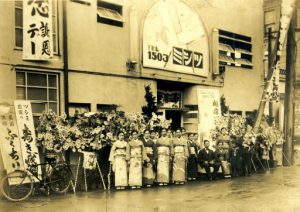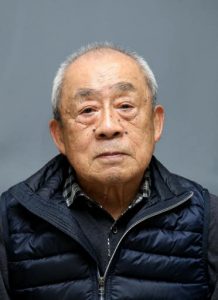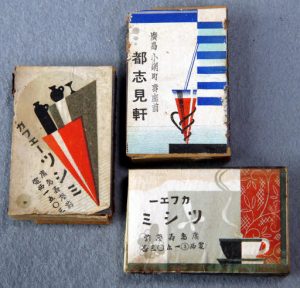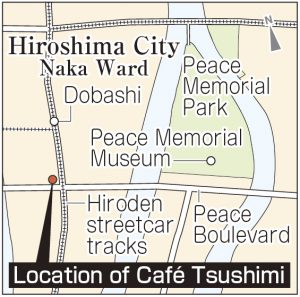Café owners’ grandson to donate photos, other items, from city’s amusement quarter before A-bombing
Mar. 5, 2019
(by Miho Kuwajima, Staff Writer)
Masakazu Yamamoto, 80, has found photos and other items among the articles left behind by his mother that convey how people lived in downtown Hiroshima before the area was destroyed by the atomic bomb. These articles are linked to his grandparents, who opened Café Tsushimi in the Koami-cho amusement quarter in the city center before the outbreak of World War II. Mr. Yamamoto, a resident of Asaminami Ward, will donate them to the Hiroshima Municipal Archives.
Saori and Woshun Kakuda opened the café around 1935. It was named after Saori’s hometown of Tsushimi, which is now part of Kitahiroshima in the northern part of Hiroshima Prefecture. The café was operated as a restaurant in the daytime and a cabaret at night, but running the café became difficult in the closing days of the war. Located 850 meters from the hypocenter, the café burned down in the atomic bombing. The bomb killed Mr. Yamamoto’s 9-year-old brother Kuniaki, who was near the café at the time, and his grandfather, who was serving as a member of the local fire brigade.
The rest of the family continued to live in the Koami-cho area after the war. When Mr. Yamamoto’s parents’ house was dismantled two years ago, he learned that his late mother had kept photos and other items connected to the café. Ten photos of the area were found. One shows his grandparents, along with employees of the establishment in kimono, lined up in front of the café when it first opened. Other images show customers smiling and chatting in the café or family members on the second floor of the café building, where they lived. One is a commemorative photo of a local defense association of women that was organized in the 1930s.
Also found were matchboxes used to help promote the café. Employing a modern design, they show the name of the café and its location. There was also a ledger from a local mutual financing association. Toshikuni Nakagawa, 62, the former director of the municipal archives, examined the items. “Almost all the materials about the Koami-cho area burned up in the atomic bombing, and very few exist,” said Mr. Nakagawa. “These things show one aspect of how people engaged in business lived in those days.”
Mr. Yamamoto said that the café used to be crowded with soldiers. When the atomic bomb exploded, he was in the Tsushimi district, a safer location for avoiding potential attacks, and he feels sorry that he survived while some members of his family perished. “My brother and I always played together when we were young, but his remains were never found. The guilt I feel toward the members of my family who died will never subside,” Mr. Yamamoto said. He has decided to donate these articles, rather than leaving them buried in oblivion, in the hope that many people see how local residents lived in those days.
(Originally published on March 5, 2019)
Masakazu Yamamoto, 80, has found photos and other items among the articles left behind by his mother that convey how people lived in downtown Hiroshima before the area was destroyed by the atomic bomb. These articles are linked to his grandparents, who opened Café Tsushimi in the Koami-cho amusement quarter in the city center before the outbreak of World War II. Mr. Yamamoto, a resident of Asaminami Ward, will donate them to the Hiroshima Municipal Archives.
Saori and Woshun Kakuda opened the café around 1935. It was named after Saori’s hometown of Tsushimi, which is now part of Kitahiroshima in the northern part of Hiroshima Prefecture. The café was operated as a restaurant in the daytime and a cabaret at night, but running the café became difficult in the closing days of the war. Located 850 meters from the hypocenter, the café burned down in the atomic bombing. The bomb killed Mr. Yamamoto’s 9-year-old brother Kuniaki, who was near the café at the time, and his grandfather, who was serving as a member of the local fire brigade.
The rest of the family continued to live in the Koami-cho area after the war. When Mr. Yamamoto’s parents’ house was dismantled two years ago, he learned that his late mother had kept photos and other items connected to the café. Ten photos of the area were found. One shows his grandparents, along with employees of the establishment in kimono, lined up in front of the café when it first opened. Other images show customers smiling and chatting in the café or family members on the second floor of the café building, where they lived. One is a commemorative photo of a local defense association of women that was organized in the 1930s.
Also found were matchboxes used to help promote the café. Employing a modern design, they show the name of the café and its location. There was also a ledger from a local mutual financing association. Toshikuni Nakagawa, 62, the former director of the municipal archives, examined the items. “Almost all the materials about the Koami-cho area burned up in the atomic bombing, and very few exist,” said Mr. Nakagawa. “These things show one aspect of how people engaged in business lived in those days.”
Mr. Yamamoto said that the café used to be crowded with soldiers. When the atomic bomb exploded, he was in the Tsushimi district, a safer location for avoiding potential attacks, and he feels sorry that he survived while some members of his family perished. “My brother and I always played together when we were young, but his remains were never found. The guilt I feel toward the members of my family who died will never subside,” Mr. Yamamoto said. He has decided to donate these articles, rather than leaving them buried in oblivion, in the hope that many people see how local residents lived in those days.
(Originally published on March 5, 2019)











